| |
Dynamics of cognitive change in impaired HIV-positive patients initiating antiretroviral therapy
|
| |
| |
Download the PDF here.
"HAND (HIV-associated neurocognitive disorders) should be proactively monitored"..... "drug regimens with the estimated CNS penetration (CPE scores greater than 2 should be selected when possible based on treatment and toxicity histories and drug resistance testing."
Published online before print May 27, 2009
(Neurology 2009, doi:10.1212/WNL.0b013e3181ab2b3b)
L. A. Cysique PhD*, F. Vaida PhD, S. Letendre MD, S. Gibson BS, M. Cherner PhD, S. P. Woods PsyD, J. A. McCutchan MD, R. K. Heaton PhD, and R. J. Ellis MD, PhD
From the Department of Psychiatry (L.A.C., M.C., S.P.W., R.K.H.), Division of Biostatistics and Bioinformatics, Department of Family and Preventive Medicine (F.V.), Department of Medicine (S.L., S.G., J.A.M.), and Department of Neurosciences (R.J.E.), University of California at San Diego; and Brain Sciences (L.A.C.), University of New South Wales, Sydney, Australia.
*To whom correspondence should be addressed. E-mail: lcysique@unsw.edu.au.
This slide is from Scott Letendre and compares 3 studies conducted reporting correlation of neuropsych improvement with CPE score:
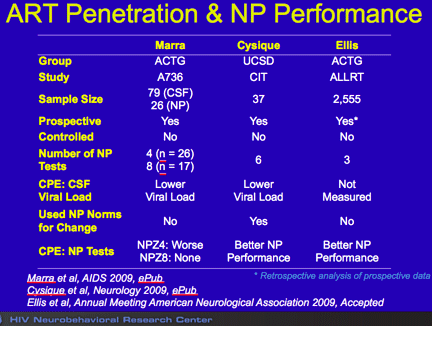
CNS penetration effectiveness (CPE)
"The therapeutic implications of our study are twofold: 1) HAND should be proactively monitored; and 2) to minimize impact of HAND on productivity and life quality, drug regimens with the estimated CNS penetration (CPE scores greater than 2; see reference 22 for details) should be selected when possible based on treatment and toxicity histories and drug resistance testing. Adherence to CART presumably also is critical to improving cognitive functions,
22. Letendre S, Marquie-Beck J, Capparelli E, et al. Validation of the CNS Penetration-Effectiveness rank for quantifying antiretroviral penetration into the central nervous system. Arch Neurol 2008;65:65-70.
NP (neuropsychological) improvement was associated with decreasing plasma HIV viral load (but not CSF, potentially due to a lack of data variability by week 12 as detailed below), whether HIV viral load was treated as a continuous or dichotomous variable, and the effect was strongest at 24 and 48 weeks after CART initiation The CPE score (greater than 2), for the participants' CART regimens, was the other predictor of NP improvement in our multivariate analyses
We hypothesized that individuals with worse baseline performance, individuals who were ART naive, and individuals who were on better penetrating CNS treatment would benefit the most. Finally, we hypothesized that both plasma and CSF viral load reduction would be associated with NP improvement.
Higher CNS penetration of the CART regimen (defined as an index χ2 using the method of reference 22) had an overall effect (p 0.005) on NP change and showed a main effect on NP change (p 0.002), but a nonsignificant time interaction effect. Specifically, CART CNS penetration χ2 yielded a NP improvement of 2.46 (95% CI 1.02, 3.91) units on the MS-Reg-CS per 12-week period. No other time-varying covariates were significantly associated with the MS-Reg-CS (table 3).
Multivariate analyses. Factors that were found to be significant predictors of NP change in the univariate model were entered as covariates in the multivariate model. Both the CNS penetration effectiveness (CPE) score (p =0.002) and baseline NP performance (continuous log10 GDS; p=0.024) remained predictive covariates. The model had an R2 value of 0.59, of which 0.56 was explained by the follow-up time (including the random slope, i.e., the time components on model 4; appendix e-1), and 0.03 by the CPE score and baseline NP performance."
ABSTRACT
Objective: To rigorously evaluate the time course of cognitive change in a cohort of individuals with HIV-associated neurocognitive disorders (HAND) initiating combination antiretroviral therapy (CART), and to investigate which demographic, laboratory, and treatment factors are associated with neuropsychological (NP) outcome (or "any NP improvement").
Methods: Study participants included 37 HIV+ individuals with mild to moderate NP impairment who initiated CART and underwent NP testing at 12, 24, 36, and 48 weeks thereafter. NP change was assessed using a regression-based change score that was normed on a separate NP-stable group thereby controlling for regression toward the mean and practice effect. Mixed-effect regression models adjusting for loss to follow-up were used to evaluate the time course of cognitive change and its association with baseline and time-varying predictors.
Results: In persons with HAND initiating CART, cognitive improvement happens soon after initiation (13% at week 12), but more often 24, 36, and up to 48 weeks after initiation (up to 41%), with fewer than 5% demonstrating significant worsening. In multivariate analyses, unique predictors of NP improvement included more severe baseline NP impairment and higher CART CNS penetration index. Greater viral load decrease was associated with NP improvement only in univariate analyses.
Conclusion: Clinically meaningful neuropsychological improvement seemed to peak around 24-36 weeks after combination antiretroviral therapy initiation and was prolonged over the 1-year study period. This study also provides new evidence that benefit may be maximized by choosing antiretroviral medications that reach therapeutic concentrations in the CNS.
GLOSSARY
ANI asymptomatic neurocognitive impairment; CART combination antiretroviral therapy; CI confidence interval; CIT Cognitive Intervention Trial; CPE CNS penetration effectiveness; GDS Global Deficit Score; IQR interquartile range; HAD HIV-associated dementia; HAND HIV-associated neurocognitive disorders; MND mild neurocognitive disorder; MS-Reg-CS mean scaled score regression-based change score; NP neuropsychological.
The temporal profile and magnitude of neuropsychological (NP) change after combination antiretroviral therapy (CART) initiation and the biologic, clinical, and treatment factors associated with this change have not been well studied.
Previous studies have showed that CART is beneficial to cognitive functions within a few months and more likely to improve in virally suppressed individuals in the plasma1 and in the CSF2,4 as well as in ART-naive persons2,4 and in persons on highly CNS-penetrating CART regimens.4,5
However, these studies have important limitations. First, only group statistics were used with no untreated comparison group. No study standardized NP change against a comparison group in order to control for practice effect and regression toward the mean, potentially providing erroneous estimates of NP improvement.6 Some included participants who were not NP impaired at baseline.2,3,5 Others did not assess the time association of HIV biomarkers and NP change.2,3
The current study has two aims: 1) to estimate the rate and nature of NP improvement in persons initiating CART; 2) to determine which demographic, clinical, laboratory, and treatment factors are associated with NP improvement.
We hypothesized that many but not all individuals would positively benefit from CART initiation. We hypothesized that individuals with worse baseline performance, individuals who were ART naive, and individuals who were on
better penetrating CNS treatment would benefit the most. Finally, we hypothesized that both plasma and CSF viral load reduction would be associated with NP improvement.
DISCUSSION
Findings from this study show that for some persons with HAND initiating CART, cognitive improvement happens soon after initiation (13% at week 12), but more often 24, 36, and 48 weeks after initiation (up to 41%). In addition, whether the initial NP improvement happens sooner or later, the magnitude of improvement was greater in individuals who had the lowest baseline performance, although improvement of lesser magnitude was observable in less impaired participants at baseline (figure 2). This does not appear to be an artifact of regression to the mean because the latter should be controlled by the MS-Reg-CS methodology. Indeed, the regression change scores were derived from a normative sample from which no NP change was expected beyond practice effect or statistical artifact such as regression toward the mean. In other words, the "normed" definition of NP change in the CIT sample was exclusive of these confounds. Moreover, the pattern of NP change in the impairment subgroups (figure 2) cannot be explained on the basis of regression to the mean because the least impaired subgroup does not show the lowest amount of improvement.
NP improvement was associated with decreasing plasma HIV viral load (but not CSF, potentially due to a lack of data variability by week 12 as detailed below), whether HIV viral load was treated as a continuous or dichotomous variable, and the effect was strongest at 24 and 48 weeks after CART initiation. This result is in accordance with previous studies.1,4 However, in the multivariate model that also includes baseline NP impairment, plasma viral load
does not remain a unique contributor. Several mechanisms to explain NP improvement have been proposed in the literature. First, CART reduces HIV replication in the brain (as well as the blood).4 As a result, circulating activated monocytes are reduced, leading to a reduction of their migration into the brain and a resulting further reduction of HIV in the CNS.23 With a reduction of HIV and activated monocytes, neuroinflammation and production of neurotoxins is also reduced.24
The CPE score (greater than 2), for the participants' CART regimens, was the other predictor of NP improvement in our multivariate analyses. The beneficial effect of CSF penetrating drugs has been observed in one other longitudinal study but only in univariate analyses.25 It was observed also over one time point in the subanalysis of this sample.4 Not only is this finding the first robust extension of the long-term beneficial effect of CART with better CNS penetration, our change score method and mixed effect modeling also yielded a specific magnitude of NP improvement of 2.46 units on average per 12-week period. This represents a large improvement arguably supporting a non-negligible effect of this factor and provides valuable information for future clinical trials. Better CART CNS penetration likely leads to more neurocognitive improvement because it better suppresses CNS viral replication.26 However, we were not able to show the latter. Potential reasons are that CSF viral load may only imperfectly reflect the state of HIV replication in the brain, that currently available viral load assays are not sufficiently sensitive for CSF, and that secondary effects of CART, such as reduction in mediators of neuroinflammation, may be important in neurocognitive recovery.
Perhaps the most likely explanation is related to the data variance, as we found that 80% of subjects suppressed CSF viral load at week 12. This leaves only 20% detectable, a very small subgroup. Thus the categorical analysis of CSF viral suppression was probably not powered to demonstrate the expected effect. By comparison, proportions remaining detectable and undetectable at week 12 for plasma were better balanced, providing more power.
The therapeutic implications of our study are twofold: 1) HAND should be proactively monitored; and 2) to minimize impact of HAND on productivity
and life quality, drug regimens with the estimated CNS penetration (CPE scores greater than 2; see reference 22 for details) should be selected when possible based on treatment and toxicity histories and drug resistance testing. Adherence to CART presumably also is critical to improving cognitive functions, and may improve with better cognition.27 Since reported levels of treatment adherence were high in this study as compared to those observed in clinical practice, extra measures to promote good adherence,
especially initially, may be needed for impaired patients to achieve results similar to ours.
Our study detected continuing improvement up to 1 year after a change in therapy. This supports findings of long-term observational cohorts demonstrating
benefit of CART up to 3 years18,28 and even in patients with immune reconstitution syndrome up to 5 years.29 This suggests that the window for recovery of HIV-related brain injury may be relatively long.
Two findings from this study differed from those which were reported in our prior analysis of the CIT data.4 First, we did not find that CSF viral load was significantly associated with NP improvement. Secondly, we did not confirm that ART naive (38%) participants were more likely to improve. We believe that these differing findings result from different analytic approaches, and the inclusion of all study timepoints. Also, the initial study measured cognitive changes with the GDS, a measure that ignores changes within the normal range. For the current
analysis, we used scaled scores which encompass the full range of performance, capturing not only return to normal, but also return to best levels of functioning.
Moreover, the prior study found that higher CNS penetration was associated with better CSF viral load suppression, but not with better neurocognitive performance. This may have resulted from the use of updated estimates of CNS penetration based on data published after 2004 in the present study, as well as better estimate of NP change.
We believe that our current approach provides a more sensitive and yet stricter estimate of cognitive improvement when compared to the published literature.
Indeed, the standardized change scores for expected NP change which were derived from a demographically comparable group of HIV- and clinically stable HIV+ participants correct for practice effects, regression toward the mean, and normal test-retest variation. These measures are more likely to reflect the "true" NP improvement without these sources of error (see figure 2 legend).
Several limitations to our study should be recognized. First, our small sample size may have limited detection of less robust contributions to improvement
by some of our predictors. Larger longitudinal studies with strategies to reduce attrition are needed. Secondly, the battery of tests ideally would have been
larger. However, we found that our limited battery was highly correlated to the original GDS derived from more comprehensive NP evaluations.4 Still, when using this prorated battery, a number of important cognitive functions known to be affected by HIV infection and effective CART were not represented (e.g., learning, memory, executive functions). Finally, we used two sets of regression equations to compute the MS-Reg-CS for four time periods (baseline-
12 weeks, 12-24 weeks, 24-36 weeks, 36-48 weeks). These equations may not account for some of the practice effects in our study at week 36 and 48.
However, several studies indicate that practice effect most substantially applies to the second assessment and is greatly diminished with subsequent tests.17
The ideal design would have been to have a reference sample of comparable individuals tested at the exact same times as our participants. This highlights the
need for normative data for NP change at various intervals relevant to clinical trials. Finally, we did not explore how cognitive improvement translated into
potential everyday functioning. Future studies should aim at defining to what extent everyday functioning measures covary with NP change.
Because most participants reported being highly adherent (more than 95% of the time) to their combination antiretroviral therapy regimen across the study (87% at week 12, 90% at week 24, 100% at week 36, and 83% at week 48), variance among patients was small andwecould not meaningfully test adherence association with NP change over time. *MCP1 was only available at week 12.
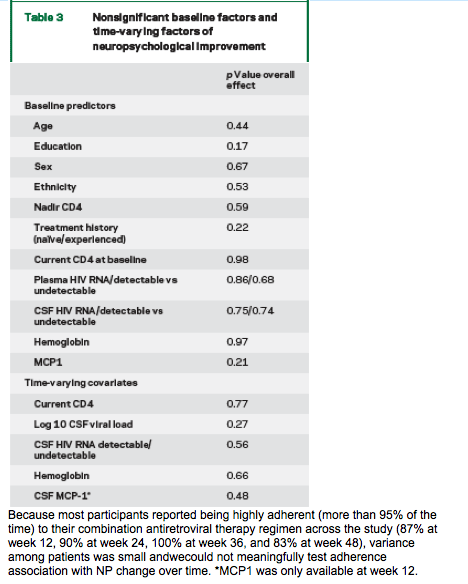
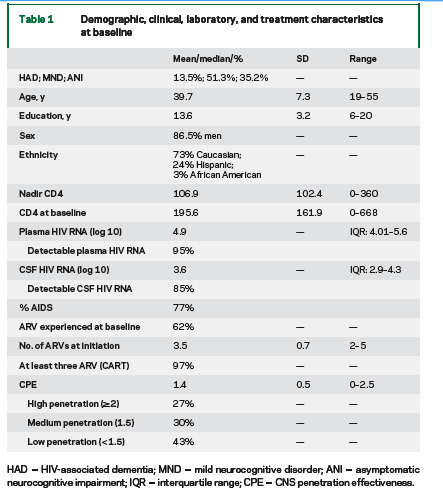
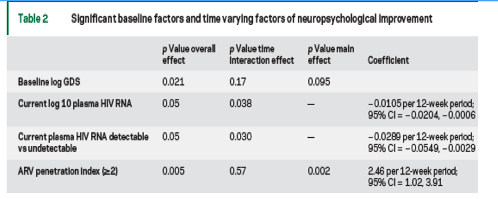
RESULTS
Frequency and pattern of NP change from baseline.
As illustrated in figure 1 and using the categorical cutoffs for a 90% CI in classifying clinically meaningful NP change, we found that between 13.5% and 40.9% of participants improved from baseline across the study time.
Results from the mixed-effect regression model showed that the average NP performance change (continuous MS-Reg-CS; figure 2) dramatically improved
at week 12 when compared to normative expectations (p <0.001). Then, when compared to week 12, improvement at week 24 was not different (p =0.11). However, improvements were found on the subsequent visits at weeks 36 (p =0.02) and 48 (p =0.003) as compared to week 12.
Change in HIV-related biomarkers.
The CD4 cell count improved sharply at week 12 (p <0.0001), and more gradually at the subsequent time points (week 36, p =0.037; week 48, p =0.015) compared to week 12 (figure e-1). The kinetics of the viral load in the plasma and the CSF sharply improved at week 12 (p< 0.0001), without significant change thereafter (figure e-2). When considering detection level (<50 c/mL) in the plasma, we found that among the 36 patients who had available viral load at baseline, 95% were detectable. At week 12, 50% (18/36) became undetectable. Then at week 24, 59% (16/27) were undetectable, 58% (11/19) at week 36, and
53% (8/15) at week 48. In the CSF, among the 34 patients had who had available viral load at baseline, 85% were detectable. At week 12, 80% (29/34) became undetectable. Then at week 24, 81% (17/21)
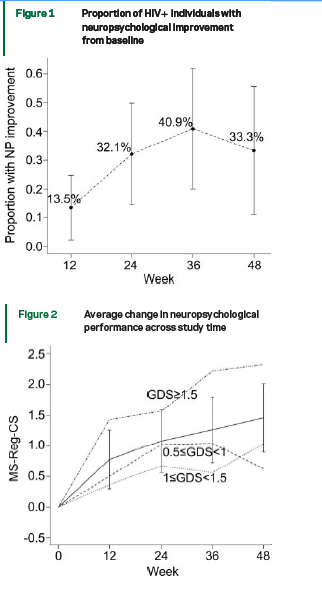
were undetectable, 69% (11/16) at week 36, and
65% (9/14) at week 48.
Predictors of NP change. Univariate analyses. Among baseline factors, only initial NP performance (continuous log10 GDS) was predictive of NP change
(p =0.021). But the main effect for baseline NP performance and the time interaction effect between baseline NP performance and NP change (here in the
absence of the interaction term) were not significant (table 2). Indeed, inspection of individual change scores and baseline performances revealed that the most marked improvements throughout the study tended to occur in individuals with lowest baseline performance (figure 2).
Among serially assessed covariates of NP improvement (time-varying covariates), we found that log10 plasma HIV RNA change trended toward an
overall effect (p =0.056) with a time-interaction effect (p =0.038; coefficient = -0.0105 log10 per week, 95% CI= -0.0204, -0.0006). These results
can be interpreted as follows: one log10 decrease in viral load is equivalent to an increase of 0.126 points in the MS-Reg-CS (NP improvement) over a 12- week period. In other words, greater reductions in plasma viral load were associated with greater NP improvements and this association increased in time by -0.0105 log10 per 12-week period.
Likewise, if change in plasma HIV RNA is defined categorically (i.e., detectable vs undetectable), we found an overall effect (p =0.050) with a time interaction (p= 0.030; coefficient = -0.023, 95% CI = -0.055, -0.0029 per 12-week period).
This
means that an MS-Reg-CS change at week 12 is 0.35 more (95% CI 0.035 to 0.66) for patients with undetectable vs detectable viral loads.
Higher CNS penetration of the CART regimen (defined as an index >/=2 using the method of reference 22) had an overall effect (p =0.005) on NP change and showed a main effect on NP change (p =0.002), but a nonsignificant time interaction effect. Specifically, CART CNS penetration >/=2 yielded a NP improvement of 2.46 (95% CI 1.02, 3.91) units on the MS-Reg-CS per 12-week period. No other time-varying covariates were significantly associated with the MS-Reg-CS (table 3).
Multivariate analyses. Factors that were found to be significant predictors of NP change in the univariate model were entered as covariates in the multivariate
model. Both the CNS penetration effectiveness (CPE) score (p =0.002) and baseline NP performance (continuous log10 GDS; p =0.024) remained predictive covariates. The model had an R2 value of 0.59, of which 0.56 was explained by the follow-up time (including the random slope, i.e., the time components on model 4; appendix e-1), and 0.03 by the CPE score and baseline NP performance.
|
|
| |
| |
|
|
|